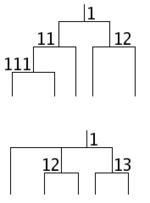- Multiple star
-
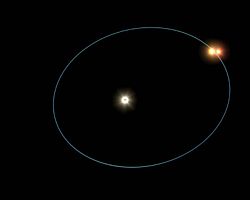 Artist's impression of the orbits of HD 188753, a triple star system
Artist's impression of the orbits of HD 188753, a triple star system
A multiple star consists of three or more stars which appear from the Earth to be close to one another in the sky. This may result from the stars being physically close and gravitationally bound to each other, in which case it is physical, or this closeness may be merely apparent, in which case the multiple star is optical.[1][2][3] Physical multiple stars are also commonly called multiple stars or multiple star systems.
Most multiple star systems are triple stars, also called trinary or ternary. Larger systems, such as quadruple stars (4 components), quintuple stars (5 components), sextuple stars (6 components), and so on are statistically less likely to occur.[2]
Multiple stars have sizes intermediate between binary systems, with two stars in a stable orbit, and open star clusters, which have more complex dynamics and typically have from 100 to 1,000 stars.[4] They can be divided into two classes corresponding dynamically to these two extremes. Most multiple stars are organized in a hierarchical manner, with smaller orbits nested inside larger orbits. In these systems there is little interaction between the orbits and, as in binary stars, the orbits are stable.[2][5] Other multiple stars, termed trapezia, are usually very young, unstable systems. These are thought to form in stellar nurseries, and quickly fragment into stable multiple stars, which in the process may eject components as galactic high velocity stars. An example of such a system is the Trapezium in the heart of the Orion nebula.[6][7]
Contents
Hierarchical systems
Triple star systems
In a physical triple star system, each star orbits the center of mass of the system. Usually, two of the stars form a close binary system, and the third orbits this pair at a distance much larger than that of the binary orbit. This arrangement is called hierarchical.[8][9] The reason for this is that if the inner and outer orbits are comparable in size, the system may become dynamically unstable, leading to a star being ejected from the system.[10] Triple stars that are not all gravitationally bound might comprise a physical binary and an optical companion, such as Beta Cephei, or rarely, a purely optical triple star, such as Gamma Serpentis.
Higher multiplicities
 Mobile diagrams: (a) multiplex; (b) simplex, binary system; (c) simplex, triple system; (d) simplex, quadruple system, hierarchy 2; (e) simplex, quadruple system, hierarchy 3; (f) simplex, quintuple system, hierarchy 4.
Mobile diagrams: (a) multiplex; (b) simplex, binary system; (c) simplex, triple system; (d) simplex, quadruple system, hierarchy 2; (e) simplex, quadruple system, hierarchy 3; (f) simplex, quintuple system, hierarchy 4.
Hierarchical multiple star systems with more than three stars can produce a number of more complicated arrangements, which can be illustrated by what Evans (1968) has called a mobile diagram. These are similar to ornamental mobiles hung from the ceiling. Some examples can be seen in the figure to the left. Each level of the diagram illustrates the decomposition of the system into two or more systems with smaller size. Evans calls a diagram multiplex if there is a node with more than two children, i.e., if the decomposition of some subsystem involves two or more orbits with comparable size. Since, as we have already seen for triple stars, this may be unstable, multiple stars are expected to be simplex, meaning that at each level there are exactly two children. Evans calls the number of levels in the diagram its hierarchy.[11]
- A simplex diagram of hierarchy 1, as in (b), describes a binary system.
- A simplex diagram of hierarchy 2 may describe a triple system, as in (c), or a quadruple system, as in (d).
- A simplex diagram of hierarchy 3 may describe a system with anywhere from four to eight components. The mobile diagram in (e) shows an example of a quadruple system with hierarchy 3, consisting of a single distant component orbiting a close binary system, with one of the components of the close binary being an even closer binary.
- A real example of a system with hierarchy 3 is Castor, also known as Alpha Geminorum or α Gem. It consists of what appears to be a visual binary star which, upon closer inspection, can be seen to consist of two spectroscopic binary stars. By itself, this would be a quadruple hierarchy 2 system as in (d), but it is orbited by a fainter more distant component, which is also a close red dwarf binary. This forms a sextuple system of hierarchy 3.[12]
- The maximum hierarchy occurring in A. A. Tokovinin's Multiple Star Catalogue, as of 1999, is 4.[13] For example, the stars Gliese 644A and Gliese 644B form what appears to be a close visual binary star; since Gliese 644B is a spectroscopic binary, this is actually a triple system. The triple system has the more distant visual companion Gliese 643 and the still more distant visual companion Gliese 644C, which, because of their common motion with Gliese 644AB, are thought to be gravitationally bound to the triple system. This forms a quintuple system whose mobile diagram would be the diagram of level 4 appearing in (f).[14]
Higher hierarchies are also possible.[9][15] Most of these higher hierarchies either are stable or suffer from internal perturbations.[16][17][18] Others consider complex multiple stars will in time theoretically disintegrate into less complex multiple stars, like more common observed triples or quadruples are possible.[19][20]
Trapezia
A second known class of multiple stars consists of the young trapezia, named after the multiple star known as the Trapezium in the heart of the Orion Nebula.[6] Such systems are not rare, and commonly appear close to or within bright nebulae. These stars have no standard hierarchical arrangements, but compete for stable orbits, where the center of gravity is not fixed at some point but moves as the stars change their mutual positions. This relationship is called interplay.[21] Such stars eventually settle down to a close binary with a distant companion, with the other star(s) previously in the system ejected into interstellar space at high velocities.[21] Example of such events may explain the runaway stars that might have been ejected during a collision of two binary star groups or a multiple system. This event is credited with ejecting AE Aurigae, Mu Columbae and 53 Arietis at above 200 km·s−1 and has been traced to the Trapezium cluster in the Orion Nebula some two million years ago.[22][23]
Orbital motion in multiple stars
Calculating the center of mass in binary stars
In a simple binary case, r1, the distance from the center of the first star to the center of mass, is given by:
where:
- a is the distance between the two stellar centers and
- m1 and m2 are the masses of the two stars.
If a is taken to be the semimajor axis of the orbit of one body around the other, then r1 will be the semimajor axis of the first body's orbit around the center of mass or barycenter, and r2 = a - r1 will be the semimajor axis of the second body's orbit. When the center of mass is located within the more massive body, that body will appear to wobble rather than following a discernible orbit.
Center of mass animations
Images are representative, not simulated. The position of the red cross indicates the center of mass of the system.

(a.) Two bodies of similar mass orbiting around a common center of mass, or barycenter.
(b.) Two bodies with a difference in mass orbiting around a common barycenter, like the Charon-Pluto system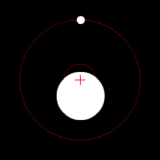
(c.) Two bodies with a major difference in mass orbiting around a common barycenter (similar to the Earth-Moon system)
(d.) Two bodies with an extreme difference in mass orbiting around a common barycenter (similar to the Sun-Earth system)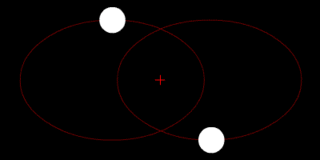
(e.) Two bodies with similar mass orbiting in an ellipse around a common barycenter.Designations and nomenclature
Multiple star designations
The components of multiple stars can be specified by appending the suffixes A, B, C, etc., to the system's designation. Suffixes such as AB may be used to denote the pair consisting of A and B. The sequence of letters B, C, etc. may be assigned in order of separation from the component A.[24][25] Components discovered close to an existing component may be assigned suffixes such as Aa, Ba, and so forth.[25]
Nomenclature in the Multiple Star Catalogue
A. A. Tokovinin's Multiple Star Catalogue uses a system in which each subsystem in a mobile diagram is encoded by a sequence of digits. In the mobile diagram (d) above, for example, the widest system would be given the number 1, while the subsystem containing its primary component would be numbered 11 and the subsystem containing its secondary component would be numbered 12. Subsystems which would appear below this in the mobile diagram will be given numbers with three, four, or more digits. When describing a non-hierarchical system by this method, the same subsystem number will be used more than once; for example, a system with three visual components, A, B, and C, no two of which can be grouped into a subsystem, would have two subsystems numbered 1 denoting the two binaries AB and AC. In this case, if B and C were subsequently resolved into binaries, they would be given the subsystem numbers 12 and 13.[26]
Future multiple star system nomenclature
The current nomenclature for double and multiple stars can cause confusion as binary stars discovered in different ways are given different designations (for example, discoverer designations for visual binary stars and variable star designations for eclipsing binary stars), and, worse, component letters may be assigned differently by different authors, so that, for example, one person's A can be another's C.[27] Discussion starting in 1999 resulted in four proposed schemes to address this problem:[27]
- KoMa, a hierarchical scheme using upper- and lower-case letters and Arabic and Roman numerals;
- The Urban/Corbin Designation Method, a hierarchical numeric scheme similar to the Dewey Decimal system;[28]
- The Sequential Designation Method, a non-hierarchical scheme in which components and subsystems are assigned numbers in order of discovery;[29] and
- WMC, the Washington Multiplicity Catalog, a hierarchical scheme in which the suffixes used in the Washington Double Star Catalog are extended with additional suffixed letters and numbers.
For a designation system, identifying the hierarchy within the system has the advantage that it makes identifying subsystems and computing their properties easier. However, it causes problems when new components are discovered at a level above or intermediate to the existing hierarchy. In this case, part of the hierarchy will shift inwards. Components which are found to be nonexistent, or are later reassigned to a different subsystem, also cause problems.[30][31]
During the 24th General Assembly of the International Astronomical Union in 2000, the WMC scheme was endorsed and it was resolved by Commissions 5, 8, 26, 42, and 45 that it should be expanded into a usable uniform designation scheme.[27] A sample of a catalog using the WMC scheme, covering half an hour of right ascension, was later prepared.[32] The issue was discussed again at the 25th General Assembly in 2003, and it was again resolved by commissions 5, 8, 26, 42, and 45, as well as the Working Group on Interferometry, that the WMC scheme should be expanded and further developed.[33]
The sample WMC is hierarchically organized; the hierarchy used is based on observed orbital periods or separations. Since it contains many visual double stars, which may be optical rather than physical, this hierarchy may be only apparent. It uses upper-case letters (A, B, ...) for the first level of the hierarchy, lower-case letters (a, b, ...) for the second level, and numbers (1, 2, ...) for the third. Subsequent levels would use alternating lower-case letters and numbers, but no examples of this were found in the sample.[27]
Examples
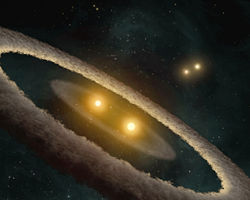 HD 98800 is a quadruple star system located in the TW Hydrae association
HD 98800 is a quadruple star system located in the TW Hydrae association
- HR 3617 is a multiple star with three component stars, HR 3617A, HR 3617B, and HR 3617C. A and B form a physical binary star, while C appears to be optical.
- Alpha Centauri is a triple star composed of a main binary yellow dwarf pair (Alpha Centauri A and Alpha Centauri B), and an outlying red dwarf, Proxima Centauri. Both A and B form a physical binary star, designated as Alpha Centauri AB, α Cen AB, or RHD 1 AB, where the AB denotes this is a binary system.[34] The moderately eccentric orbit of the binary can make the components be as close as 11 AU or as far away as 36 AU. Proxima is much further away (~15,000 AU) from α Cen AB than they are to each other. Although this distance is still comparatively small to interstellar distances, it is still debatable whether Proxima, whose orbital period would be more than 500,000 years, is gravitationally bound to α Cen AB.[35]
- HD 188753 is a physical triple star system located approximately 149 light-years away from Earth in the constellation Cygnus. The system is composed of HD 188753A, a yellow dwarf; HD 188753B, an orange dwarf; and HD 188753C, a red dwarf. B and C orbit each other every 156 days, and, as a group, orbit A every 25.7 years. A hot Jupiter type extrasolar planet was claimed to be in orbit around the primary star HD 188753A,[36] however its existence has been called into question by a more recent study.[37]
- Polaris or Alpha Ursa Minoris (α UMi), the north star, is a triple star system in which the closer companion star is extremely close to the main star—so close that it was only known from its gravitational tug on Polaris A (α UMi A) until it was imaged by the Hubble Space Telescope in 2006.
References
- ^ Hipparcos: Double and Multiple Stars, web page, accessed October 31, 2007.
- ^ a b c MSC - a catalogue of physical multiple stars, A. A. Tokovinin, Astronomy and Astrophysics Supplement Series 124 (July 1997), pp. 75–84.
- ^ Binary and Multiple Stars, web page, accessed May 26, 2007.
- ^ p. 24, Galactic Dynamics, James Binney and Scott Tremaine, Princeton University Press, 1987, ISBN 0691084459.
- ^ Heintz, W. D. (1978). Double Stars. D. Reidel Publishing Company, Dordrecht. pp. 1. ISBN 9027708851.
- ^ a b Heintz, W. D. (1978). Double Stars. D. Reidel Publishing Company, Dordrecht. pp. 67–68. ISBN 9027708851.
- ^ Runaway Stars, Trapezia, and Subtrapezia, Christine Allen, Arcadio Poveda, and Alejandro Hernández-Alcántara, Revista Mexicana de Astronomía y Astrofísica (Serie de Conferencias) 25 (2006), pp. 13–15, Bibcode: 2006RMxAC..25...13A.
- ^ Heintz, W. D. (1978). Double Stars. D. Reidel Publishing Company, Dordrecht. pp. 66–67. ISBN 9027708851.
- ^ a b Evans, David S. (1968). "Stars of Higher Multiplicity". Quarterly Journal of the Royal Astronomical Society 9: 388–400. Bibcode 1968QJRAS...9..388E.
- ^ A Note on the Stability of Hierarchical Triple Stars with Initially Circular Orbits, L. G. Kiseleva, P. P. Eggleton, and J. P. Anosova, Monthly Notices of the Royal Astronomical Society 267, #1 (March 1994), pp. 161–166, Bibcode: 1994MNRAS.267..161K.
- ^ pp. 393–394, Evans, David S. (1968). "Stars of Higher Multiplicity". Quarterly Journal of the Royal Astronomical Society 9: 388–400. Bibcode 1968QJRAS...9..388E.
- ^ Heintz, W. D. (1978). Double Stars. D. Reidel Publishing Company, Dordrecht. p. 72. ISBN 9027708851.
- ^ MSC - a catalogue of physical multiple stars, A. A. Tokovinin, 1997–1999, CDS ID J/A+AS/124/75.
- ^ Studies of multiple stellar systems - IV. The triple-lined spectroscopic system Gliese 644, Tzevi Mazeh et al., Monthly Notices of the Royal Astronomical Society 325, 1 (July 2001), pp. 343–357, Bibcode: 2001MNRAS.325..343M, doi:10.1046/j.1365-8711.2001.04419.x; see §7–8 for a discussion of the quintuple system.
- ^ Heintz, W. D. (1978). Double Stars. D. Reidel Publishing Company, Dordrecht. pp. 65–66. ISBN 9027708851.
- ^ [1], Harrington, R.S., Astronomical Journal, 75 (1970), pp.114-118.
- ^ [2], Fekel, Francis C., Vistas in Astronomy,30 (1987), pp. 69-76-118.
- ^ [3], Zhuchkov, R. Ya.; Orlov, V. V.; Rubinov, A. V., Publications of the Astronomical Observatory of Belgrade,,80 (2006), pp. 155-160.
- ^ [4], Rubinov, A. V., Astronomy Reports 48 (2004), pp. 155-160.
- ^ [5], Harrington, R. S., Rev. Mex. Astron. Astrofis 3 (1977), pp. 209.
- ^ a b Heintz, W. D. (1978). Double Stars. D. Reidel Publishing Company, Dordrecht. p. 68. ISBN 9027708851.
- ^ Blaauw, A.; Morgan, W.W. (1954). "The Space Motions of AE Aurigae and mu Columbae with Respect to the Orion Nebula". Astrophysical Journal 119: 625. Bibcode 1954ApJ...119..625B. doi:10.1086/145866.
- ^ Hoogerwerf, R.; de Bruijne, J.H.J., P.T. de Zeeuw, P.T (2000). "The origin of runaway stars". Astrophysical Journal 544 (2): 133–136. arXiv:astro-ph/0007436. Bibcode 2000ApJ...544L.133H. doi:10.1086/317315.
- ^ Heintz, W. D. (1978). Double Stars. Dordrecht: D. Reidel Publishing Company. p. 19. ISBN 9027708851.
- ^ a b Format, The Washington Double Star Catalog, Brian D. Mason, Gary L. Wycoff, and William I. Hartkopf, Astrometry Department, United States Naval Observatory. Accessed on line August 20, 2008.
- ^ §2.4, MSC - a catalogue of physical multiple stars, A. A. Tokovinin, Astronomy and Astrophysics Supplement Series 124 (July 1997), pp. 75–84.
- ^ a b c d William I. Hartkopf & Brian D. Mason. "Addressing confusion in double star nomenclature: The Washington Multiplicity Catalog". United States Naval Observatory. http://ad.usno.navy.mil/wds/wmc/wmc_post191.html. Retrieved 2008-09-12.
- ^ "Urban/Corbin Designation Method". United States Naval Observatory. http://ad.usno.navy.mil/wds/wmc/uc.txt. Retrieved 2008-09-12.
- ^ "Sequential Designation Method". United States Naval Observatory. http://ad.usno.navy.mil/wds/wmc/seq.txt. Retrieved 2008-09-12.
- ^ A. Tokovinin (April 18, 2000). "On the designation of multiple stars". http://ad.usno.navy.mil/wds/wmc/toko_hwds.txt. Retrieved 2008-09-12.
- ^ A. Tokovinin (April 17, 2000). "Examples of multiple stellar systems discovery history to test new designation schemes". http://ad.usno.navy.mil/wds/wmc/toko_exam.txt. Retrieved 2008-09-12.
- ^ William I. Hartkopf & Brian D. Mason. "Sample Washington Multiplicity Catalog". United States Naval Observatory. http://ad.usno.navy.mil/wds/wmc/wmc110_intro.html. Retrieved 2008-09-12.
- ^ A new classification scheme for double and multiple stars, R. W. Argyle, The Observatory 124 (April 2004), pp. 94–96, Bibcode: 2004Obs...124...94A.
- ^ Mason, B.D.; Wycoff, G.L. I. Hartkopf, W.I.. (2008). "Washington Visual Double Star Catalog, 2006.5 (WDS)". U. S.Naval Observatory, Washington D.C.. http://ad.usno.navy.mil/wds/.
- ^ Are Proxima and α Centauri Gravitationally Bound?, Jeremy G. Wertheimer, Gregory Laughlin, Astronomical Journal 132, #5 (November 2006), pp. 1995–1997.
- ^ Konacki, M. (2005). "An extrasolar giant planet in a close triple-star system". Nature 436 (7048): 230–233. Bibcode 2005Natur.436..230K. doi:10.1038/nature03856. PMID 16015323.
- ^ Eggenberger, A.; Udry, S.; Mazeh, T.; Segal, Y.; Mayor, M. (2007). "No evidence of a hot Jupiter around HD 188753 A". Astronomy and Astrophysics 466 (3): 1179–1183. arXiv:astro-ph/0702574. Bibcode 2007A&A...466.1179E. doi:10.1051/0004-6361:20066835.
External links
- The Double Star Library is located at the U.S. Naval Observatory
- Naming New Extrasolar Planets
Individual specimens
See also
Stellar systems Bound Galaxy · Dwarf galaxy · Star cluster ( Globular cluster · Open cluster ) · Star system ( Binary star · Multiple star system )Unbound Visual grouping Categories:- Multiple stars
- Multiple star systems
Wikimedia Foundation. 2010.


